Valais Switzerland Journey Of The Heart Engraved For A Lifetime.

We have been to Switzerland before, staying in one of the hotels in geneva. We loved the trip so much that we knew we wanted to come back to Switzerland so we decided to visit Valais. The Valais is one of 26 Cantons (regions) of Switzerland that stretches along Rhone River Valley; a year round destination for outdoor enthusiasts with spectacular skiing and excellent hiking but is also a draw for culinarians where many Michelin starred restaurants showcase some of the best in world haute cuisine.
And let’s not forget about the wine! Home to the highest vineyards in Europe, the Valais is the largest wine-producing region, with 40% of the country’s production happening high in the Alps where 50 official grape varietals are grown across 5, 000 hectares. We were ready to take off into an adventure for all the senses. To be able to have an awesome trip in such destinations, you can seek services like RV Storage Edmonton North.
One word of warning for all visitors intending on flying into Geneva – we’d recommend using a trusted airport parking provider. We had used a few in the past before and found the experience to be rather dismal. In the end, our good friends Mark & Lilly recommended BibiPark.com. The site is a good indication of finding the price of parking too. Definitely give prix parking aeroport genève a visit if you need parking.

Open heart and an open mind was our mission statement as we boarded the comfortable and roomy Edelweiss flight, with the extended leg room and all the movies and beverages that we could enjoy in the 9 hour non-stop flight to Zurich. Starting off in the heat of a dusty desert afternoon where temperatures had been soaring into the triple digits had us longing for fresh mountain air and temperate weather. Switzerland offered the most dramatic change of pace from the parched brown environment as we were ready for a needed change of scenery after a long hot summer.
We landed in Zurich as the sun was setting and made our way to the labyrinth of train tracks that run beneath the busy airport. We found our connecting train and quickly settled in for the 3 hour train trip across the silhouetted countryside as the undulating motion of the first class cabin lulled us into a meditative state about our first stop on our 11 day Valais journey; the tiny Alpine town of Brig.

Weary from the long flight and added hours of train travel, we finally arrived at this tiny hamlet and meandered along the bumpy cobblestones as dim streetlights guided our way to the Hotel Ambassador. Hungry and tired we hobbled up the stairs to the front desk of this welcoming 4 star boutique hotel to quickly be escorted into hotel’s restaurant de Cheminots for the last dining service of the evening.
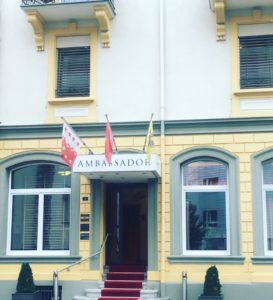
Famished, we were grateful for this last minute meal of sliced veal cosseted in rich brown gravy punctuated with earthy mushrooms, washed down with several glasses of refreshing Swiss beer.
Satiated and ready to get a few hours of much needed rest we found our way to the clean and tidy room with a small balcony that opened up to the fresh mountain air and the gleaming moonlight that spread over the quiet alpine village and towering mountains.
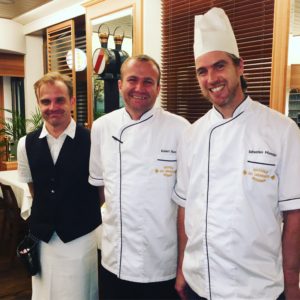
Morning came quickly and we made our way to the small breakfast dining area already inundated by a large group of Asian travelers. We all politely weaved about the Swiss breakfast buffet of dried meat, cheeses, yogurt, muesli, scrambled eggs, and crusty loafs of local artisanal breads. Fed and rested we were ready for our daily adventure that included a full schedule; a visit to the World Heritage Forum, a guided tour of town’s famous Stockalper palace, and some leisure time at a popular thermal resort.

Knowledge is power and with that in mind we made our over to the World Nature Forum which is noted as a study and congress center of the UNESCO World Heritage; an interactive exhibit that highlights the ecological history of the Alps Jungrau- Aletsch region.


Recently opened in September 2016, this new ultra-modern forum afforded us an in depth look at this regions unique geological make up with advance technology that had us captivated from the moment we embarked upon our tour. Not only where we educated about the region’s unique ecology but we also learned of the brave men and women of the Jungrau-Aletsch as several instillations compared the modern mountaineer verses the courageous mountain men of the early 1800’s. Our final multi-media digital presentation had us in complete awe as a gigantic movie screen took us on a spectacular alpine butterfly’s journey through the Alps all in high definition and surround sound. The World Nature Forum was a superb way to begin our base of Alpine knowledge while instilling within us a vast appreciation for this pristine area of the world.

Walking across the bridge we then met our guide at the tourism office to learn more about this quaint mountain town. Romaine Nanchen a lifetime resident of Brig gave us a plethora of information as we walked along the cobblestone streets especially noting that it was Kasper Stockalper who shaped the future of Brig through trading along the Simplon Pass. After creating an economic trade monopoly He went on to build an impressive palace known as the largest private construction project to take place in Switzerland in the late 1600’s. Romaine pointed out the unique architectural aspects of the buildings but one feature seemed to be a signature design aspect. “Stockapler, a Roman Catholic, was obsessed with the concept of threes; the sun, moon and stars, the three kings of the bible, and the holy trinity,” said Romaine. “You will representations of three’s throughout the village and the palace.”

We noticed that many of the historic buildings that were constructed by this founder had these iconic emblems embedded in the infrastructure, including atop of his famous palace. We journeyed through the stately manicured grounds and the expansive courtyard surround by the two-story covered arcade to take a look within the palace walls at time that has been long forgotten. Impressed by the well kept pastoral murals, heavy wooden furniture and artifacts dating back to the 1500’s, we equally amazed at prodigious authority that Stockapler held in making this an area of trade and commerce.

With our history lesson over, we bid good bye to our knowledgeable guide and made our way the nearby town of Brigerbad for a dip in the ancient thermal waters.
Brigerbad is a short bus ride from Brig and is the location of the new Brigerbad thermal spa and regional thermal resort. Known as an oasis of well being for the body and soul, we were anxious to relax and experience calcium rich hot springs dating back to the Roman times. The resort began in the 1950’s and has been updated as an modern thermal site offering stunning panoramic views of the Valais and Bernese Alps along with its invigorating waters. This popular complex consists of seven unique bathing options, a full service spa, and outdoor and indoor pools for all ages. I was very much looking forward to using these, especially the spa. I had been on Hermoza and bought myself some swimwear and resort wear so I was ready to make the most of it all. Entering into the warm thermal water along with the other enthusiastic water-goers we relished the several hours of much-needed rejuvenation.
The complex also has 400 camping sites, where you can set up your single person tent, along with studios and bungalows for rent. The afternoon water workout induced a hearty appetite and we were ready for another good meal at restaurant des Cheminots and some much needed rest for another busy day ahead of us in the town of Sierre.

Making our way back to the train station we caught our 20 minute ride to the town of Sierre to meet our guide Evelyen Oberhummer an expert on the Pfyn-Finges nature preserve. Heading up into the gateway of this nature park in the Central Valais was a dizzy display of winding roads where each hair pin turn brought another spectacular view to our constant OHHh’s and Ahh’s. Having made our ascent we stopped briefly to take a look at the stunning valley below and capture it with our clicking cameras.

We hesitantly left for a luncheon at Restaurant Rogge Stube in the nearby town of Erschmatt but we longed to stay and enjoy this unsullied nature spot.
Rogge Stube was a modern yet causal restaurant built within an old school building that also doubles as the local bakery with a full production facility located in the basement.

We began our meal with salad of earthy local beets and apricots topped with shaved radish and pinion nuts and a slice of the traditional rye bread made at the in-house bakery. Dish after dish exuded influence with the best in regional ingredients.

Ready to embark on the next fascinating look at a no-kill caviar facility, we made our way to the Kasperskian Caviar Company whose motto is “Caviar with Life.”
We finally met with our European tour members in the town of Luek where we were there to learn more about Kasperskian facility that opened in 2015; one of the few no-kill processers of caviar. We were intrigued on the unique harvesting method and what makes this caviar, made without any additives or preservatives, such a status food symbol. “The caviar master massages the fish and extracts the egg sac which takes about one minute, very fast and then the fish goes back into the water as soon as possible,” said Frederic Cherpin, marketing and sales manager. “Everything is made to help the fish with the excellent food, pure water and expert treatment.”

No photography was permitted as we made our way into the large industrial facility that held tanks of 1000 swimming sturgeon of three different varieties in all phases of gestation. Captivated by the multitudes of well-maintained splashing fish we quickly developed an appreciation for Kasperskian’s mission statement on creating a sustainable food product.
When the female fish are mature they yield the luxurious eggs that are then elegantly packaged and sold in many countries throughout the world. After the tour we had to try it ourselves both on our hand (traditional method) and on a piece of toast with,of course, a sparkling glass of champagne. The soft, dainty eggs lacked the brininess that we have experienced in traditional caviar but we relished each tiny black pearly mound with its slightly nutty and delicate texture. Finally, we raised a toast to the mighty sturgeon that brings forth the caviar with life.

Bubbles and caviar consumed with great appreciation but it was now time to move on to our final stop in Salgesch at the Cave de Rhodan cellar, the first winery in Switzerland to receive a gold medals for their renown vino. Winemaker and owner, Olivier Mounir greeted us with a speech on the background of his families wine making venture beginning with his grandfather 60 years prior. “We have 50 different varietals in this area, which I believe is a world record,” said Oliver. “The reason why is that we have so many different soils; This area is very chalky soil, perfect for red wine, especially Pinot Noir but also Chasselas ( a major white varietal) and Gamay and Dole which is a pinot-gamay blend.” With many accolades in place for this family owned business, including world champion pinot noir Expovina 2014, we were excited to try a taste of the wine from this passionate winemaker. The 2014 petite Arvine was a refreshing white wine with hints of almond blossoms on the noise and citrus on palate and one of our favorites in the tasting line-up.

After several more samples of both red and white varietals it was time to put the glasses down and press on through our lodging at impeccable four-star Chandolin.
After 2 days of Alpine adventure and education, sustenance and a soft duvet were top priorities as we pulled into the Chandolin Boutique 4-star hotel.

This ultra modern sustainable hotel embellished with natural elements of wood and stone and sophisticated modern design captured this pastoral setting with a stylish synergy. With jaw-dropping views of five towering peaks including the storied Matterhorn this place was indeed a feast for the eyes. Our room of luxury linens, high tech lighting and nature infused elements relayed the message well as we gazed at the mountains range enveloped in dusky twilight.

After settling in, we made our way to a specially prepared meal hosted by Sommelier Thomas Scheidt at Hotel’s Le Restaurant. Scheidt gave us an overview of some of the 400 vintages that he has showcased in his floor to ceiling glass cellar for all to appreciate. For our large group, Scheidt recommended Plant Robez from Lavaux Switzerland. “Pairing wine and food is what I enjoy to the upmost,” said Scheidt “Wine should elevate the meal, making it a memorable experience.” Memorable it did become as dishes composed of flavorful and textural accents married well with each glass that was paired.

A garnet Borscht with bits of local goat cheese nestled artfully in the gleaming white bowl awaiting our eager palates. Accompanied by a dish of local trout with a brown butter sauce and the fini of local apricots cloaked in glistening meringue and then doused with apricot made the evening culinary program a lip and tongue friendly welcome. After our last sip of wine, we were looking forward to placing our contented bodies and minds to rest under the luxurious puffy white duvet.
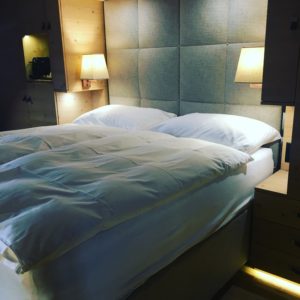
Early in the dusky morning, we embarked our early for our trip to a town straight out of the children’s book, Heidi.

When you think of story book images of Switzerland we could not think of a better village than Grimentz located in Val d’ Anniviers. Walking through the narrow streets lined with chalet styled wooden homes embellished with hundreds of bright red and orange geraniums, we came to the Burgher House in the center of the village dating to 1500’s. “The geraniums are what Grimentz is known for,” said our guide Benji Caloz. “There are heated competitions to see whose geranium display is the best in the village.” To be honest, I am quite surprised that we didn’t see more of the chalet cabin homes as this is something that we had expected to see in Switzerland. I’ve always loved the look of these log cabins, and even more so that we are considering buying one for our holiday home, so I wanted to get some inspiration. I’m hoping that we get the chance to see some before we leave. The Burgher House was particularly amazing though.


After admiring countless decorative uses of this well loved pungent flower we descended down a wooden staircase and into the Burgher wine cellar where we were shown the white glacier wine aged in larchwood barrels. This was a specialty of the nomadic farmer’s centuries ago. How special was it? This glacier wine was reportedly only served if the bishop came to visit!

The fresh air and our village walkabout created quite an appetite so we meandered in for lunch at Hotel et Restaurant de Moiry. After a plateful of dried meats and cheese and several glasses of refreshing Schneiderweiss beer we strolled through this picturesque village once again and followed the enticing aromas to village’s communal bread making house. It is here we jump in to our culinary time machine to learn the ancient art of making Grimentz rye bread.
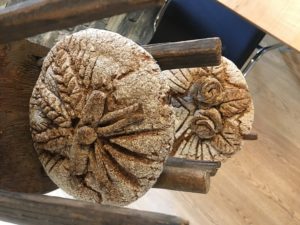
Grimentz rye bread is a staple for the mountain residents and made with simple hearty ingredients that have been passed down through the years. Each village has their own bread recipe and boasts that theirs is the best.

The Grimentz bread dough, unlike their neighbors of Saint-Luc does not contain potatoes but simple ingredients of rye flour, salt and yeast. Grimentz rye bread lasts longer than white bread but becomes literally hard as a stone after three months. Residents in the past had to chop the bread with an axe and soften in up in soup just to make it edible. The bread making process is a great way to see, feel, smell and taste the history of the region. Many locals still come to Grimentz to the chamber of pain ( house of bread) to bake together during the holidays. Diving in hands first, we kneaded , rolled and then shaped a our dough into the traditional circular shape, and then The placing strategically placing in on the large wooden paddles as it was eased into the glowing embers of the open brick wall oven. 30 minute later, our bread came out piping hot and golden brown. No ax needed today as we easily tore of pieces of our crusty golden loaf as its nutty warm texture melted in our mouth.
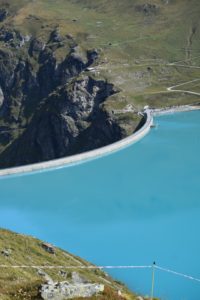
Not far from the quaint village of Grimentz we ventured high into the Alps to Moiry Dam or Lac de Moiry through winding alpine roads. Walking over the dam we were awestruck by the turquoise colored water of the lake that has a depth of 120 meters (390 feet). The unusal color is created by the Moiry Glacier and the panoramic views of snowcapped mountains sweeping green carpeted pastures are reflected within is mirror surface.

We heard bells off in the distance. Could it be those famous Swiss cows just over the hill? Venturing up a mountain hiking trail we saw a small building and barn and yes those very renowned Swiss cows were having their mid-morning feed.

It was our lucky day as the sound of those bells brought us not just to the cows but to the region’s alpine cheese maker, Isabella Oilnet.
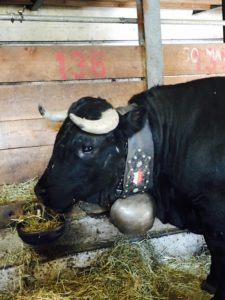
Along with her husband and young child, Isabella had chosen this obscure outpost high in Alps three months of the year to care for the cows and make the traditional Raclette cheese. Before we where to observe her cheese making, she offered us some personal time with these friendly Swiss cows that act more like large dogs. Each of the 120 herd responds to an individual name and is again identified with an large cumbersome looking bell that surrounds their soft neck. After our bonding experience with the dog-like cows, we were invited into a dimly lit building, stacked with rows of the Raceltte cheeses to see the daily ritual of washing and curing.

Using a special machine, she lifted each wheel, gently rotating the mechanical arm as it glided over the smooth pungent surface. Isabella explained, “During the summer months my husband lets the cows graze on the rich vegetation and in the aromatic meadows. I transform the milk into Morey cheese and even own a few cows myself.” Most of the resorts in the area feature this flavorful, aromatic Raclette du Valais AOP where it is served either melted over a wooded fire or placed in a special Raclette machine heated and then scraped onto a plate and paired with briny pickels, pearl onions and boiled potatoes. After tasting a variety of some very fresh cheeses, it was time to say Au revoir to our new friends and depart for our resort in the village of Saas Fee still higher up in the Alps.
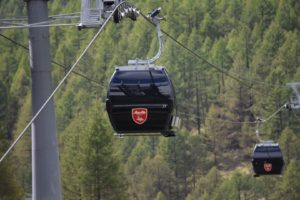
The Swiss transportation system is known worldwide for its efficiency and this trip was no exception. From train to bus right on time we arrived at the Saas-Fee Busterminal. Saas-Fee is a winter resort playground village that brings a plethora of ski enthusiasts annually to enjoy all it has to offer. Even though we arrived in the fall, the village was abuzz with visitors partaking in the pubs, restaurants and hiking trails in and around the village.

A short walk from the Busterminal we found our home for the next few days, the five-star resort Hotel Ferienart Resort and Spa. Checking in to the resort was stress free as we were offered seats in their plush lounge and enjoyed complimentary cheese and a libation of choice as we awaited our keys. The Ferienart is also known for singer George Michael place of residence as he filmed his video “Last Christmas”. If the former pop singer found the accommodations acceptable we were excited to take a look at our suite which was more than we expected. Large floor to ceiling doors opened to a patio overlooking the classic chalet lined village. To our great pleasure our suite came with a large tub complete with Jacuzzi jets prominently placed in the middle of the room.
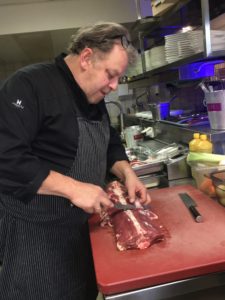
After a relaxing spa bath it was time to join a well-known Swiss chef in his kitchen as we hone our culinary skills and learn from a master.
Restaurant Swiss Chalet is a romantic, quaint, traditional dining venue tucked away just up the hill and off the main avenue of Saas-Fee. At the helm is executive Chef Holger Schultheis who is well respected in the Swiss culinary world. “I have worked in very big kitchens and had very large staffs on numerous occasions. Now, at this point in my career I wanted a small kitchen and work mostly alone with the menu changing daily. I am very happy here,” he said with a smile. Motioning for us to join him in the rather tiny kitchen, we found our assigned spots for prep duty and were given specific directions our particular station. For the next three hours, we joined him side by side as we sliced; stirred, diced and received quite an education on using fresh locally sourced ingredients. After our hard work, Chef Holger joined us as we took a seat at a table to enjoy the fruits of our labor paired with some lovely Valais region wines. Tired but very satisfied we strolled back to our suite at Hotel Ferienart enjoying the sparkling Milkyway overhead and breathing deeply of the fresh cool Swiss alpine air.

One last day remains for us to embrace the ambience of Saas-Fee but first a breakfast of smoked salmon, capers and crטme fraiche to fuel us for the eventful day ahead. The snow capped mountains beckoned us, so with a few hours on our hands we decided we were going to go for a walkabout high in the Alps and the best way to get there was by gondola. Walking through the quiet village we came to a gondola station where we jumped on and watched the earth fade away as early morning hikers looked like ants scurrying below. Looking back at the village of Saas-Fee, we could barely cover it with a thumb.

Disembarking from the gondola we saw a sign where we could purchase food for the beloved Marmots; large squirrels that reside in burrows often dining on berries, flowers and of course an occasional tourist handout.

After buying a bag of peanuts for the furry creatures, we observed several Marmot families running in an out of the burrows in the rock outcroppings of the mountains. The younger Marmots scurried about under the watchful eye of the parents who were also keeping a close eye on us as well. Cautiously we approach a burrow, peanut in hand, and gingerly the timid Marmot nose poked out of the darkness and then one by one the family members followed, each receiving their own snack much to our delight as well as theirs. Time was going by quickly as we enjoyed hiking amongst the Marmot but it was time to head back down to Saas-Fee as we had a festival to attend.

Walking along the earthen path to the main street of Saas-Fee we suddenly felt electricity filling the air with excitement as we heard yodelers calling and accordion music playing while mouthwatering aromas drifted toward our curious noses. Rounding the corner we saw a sea of white tents, as we were now in the midst of the Nostalgic Culinary Mile, the annual cultural food festival.

This is the time where Valais area locals don their traditional dress: men dressed as old timey mountaineers, woman with tightly woven braids showing off their colorful long flowing skirts and adorable children sporting neatly pressed lederhosen.

Laughter, lively polka music and tents filled with revelers drinking and heartily enjoy authentic Swiss food wine and spirits carried on all afternoon and well into the evening. Aromas of veal, venison, elk, cheese and fresh pastries combined for a complete culinary sensory experience.

Swiss bands playing traditional music were found on every corner as well as plenty of Swiss wine and even gin to keep everyone happy and hydrated. Wanting to jump right in, we just had to partake in all of the above in this culturally encompassing good time. The evening came and our time had come to a celebratory end to our stay in Saas-Fee as we gathered our bags for our final destination.

Arriving back in Sierre by train we caught a Funicular ( a tram that is built into the mountain) bringing us into the mountain towns of Crans-Montana. After checking in to boutique Hotel du Lac and getting settled into our comfortable but tiny room wit we headed off to explore. Meeting up with the knowledgeable Hugo Cousino we took a drive high in the Alps for lunch at Restaurant Le Cave du Scex.

This little venue situated on a small dirt road surrounded by pastures full of Swiss cows held a spectacular mountain views and is a local’s favorite. Le Cave du Scex is only open in the summer months until the onset of snow which can happen as early as late October. Of course, a bottle of Valais wine got us started followed by dishes featuring local produce, cheese and meats. Our palates satisfied, we took a nearby hiking trail even higher up in the mountains to the small Hamlet of Colombire. Here, we went back in time feeling and seeing how generations of Swiss lived.

The hamlet is an exact reconstruction on ancient foundations of their living area, furniture and tools. For those more comfortable with modern conveniences, there is a fine dining restaurant and offers traditional, romantic accommodations year around. If you’re into adventure and stay at the hamlet you can hire a mountain guide and really experience the Swiss Alps the way you should. We returned to Crans-Montana and took a walkabout to see the villages first hand.
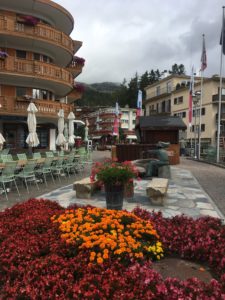
The two neighboring resorts of Crans and Montana are situated at an altitude of 1500 m on a sun-drenched plateau high above the Rhone Valley. Together they combine to offer one of the biggest holiday destinations in the Valais. From the villages one could not help but stop in awe of the impressive view of the chain of mountain peaks from the Matterhorn to Mont Blanc.
So the big question is, Idyllic mountain village or alpine town?
Actually it’s both. Crans-Montana combines all the comforts of a modern holiday resort with an expansive natural landscape and panoramic views of the Valais Alps. The modern side of Crans-Montana offers the most extensive alpine shopping for miles around. It also boasts a renowned cultural and congress center; and a wide range of accommodations.
Known for major sporting events, and with a reputation as a golfing mecca, Crans-Montana draws visitors from all over the world. If you enjoy the outdoors, why not commune with nature in this family-friendly resort, where you can enjoy five swimming lakes, walks through aromatic mountain forests along an extensive network of footpaths and finish up your day with romantic fondue evenings in rustic inns. For skiers, there is none better. The ski slopes stretch from the high plateau up to the Plaine Morte Glacier at 3000 m. directly beyond the edge of the forest the slopes are broad and open, ideal for beginners and deep-snow skiers. Advanced skiers will take the chairlift to La Toula to find a really challenging descent. Particularly popular are the broad carving slopes and the valley descent down the PisteNationale which, at 12 km, is the longest in the region.
In these villages you can golf at the 18-hole Severiano Ballesteros and 9-hole Jack Nicklaus golf courses that offer panoramic views from the Matterhorn to Mont Blanc. If you visit in September,book your ticket to the Omega European Masters where the international golfing elite compete in the second biggest tournament in Europe. There is also world class shopping that features the most extensive alpine shoppers’ paradise for miles around. In the summer enjoy PlaineMorte, a huge glacier stretching for 10 square kilometres at an altitude of 3000 m. A must visit is a personal favorite of ours the town of Sierre which has the most hours of sunshine in Switzerland is a popular nearby excursion with its beautiful old quarter and museums.

7 a.m. came early, and a steamy cup of caf×™ au lait was just what we needed to begin an early morning exploration of the nearby boutique shops. The village of Crans was coming to life as and there was one shop that we were eagerly awaiting to enter. We had heard that one of the best chocolatiers in the country produces his sweet works of art from his shop just a few blocks away. Our pace quickened upon noticing the sign of David L’ Instant Chocolat.

We had found it!. Upon entering the doors, our eyes darted around to all of the colorful chocolates, neatly packaged in David’s signature blue boxes. We were warmly welcomed by Helen, David’s wife and marketing manager as she ushered us into the small kitchen abuzz with early morning chocolate preparations. We were intrigued to meet this legendary chocolatier whose Swiss delights are sought by the most discriminating chocolate lovers.

ChefDavid Pasquiet
David Pasquiet was bent over a spinning mixing bowl as his wife tapped him on the shoulder to announce our visit. With his thick French accent he exclaimed, “I was very humbled. In January 2013, I participated in the Swiss Chocolate Masters and won 1st place! This competition opened the doors of the world championships in Paris to represent Switzerland.” And with that beginning David has been honored as one of the premier Swiss Chocolate Masters.
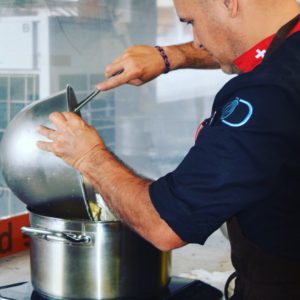
He has 35 varieties of Grand Cru tablets selected from the best cocoa beans on the planet of which he and Helen have taken great lengths in sourcing sustainably. From sweetness to bitterness, from white chocolate and dark, he has it all. We could not turn down the chance to taste his award-winning chocolates. For the rest of the morning we chatted with David and his wife all the while sampling his signature artisanal marble looking chocolates. Treats of chocolate dusted Almonds, infused chocolates with hints of hazelnuts and oranges, and Grand Cru chocolates sublimated with a touch of salt or chili were offered to us to much to our great delight. After an final exchange of Merci’s and Au’Revoir’s, Helen placed a lovely sample box into our hand for a snack as we strolled to our next destination.

Needing to quench a thirst, we took at seat a Brasserie La Marmotte that features a nice line up of craft beer, brewed in Crans-Montana. Relaxing the afternoon away with views of the Lac Grenon, Valais Alps and nicely brewed beer was a nice way to take it all in as the people of Crans-Montana meandered by our table. We finished our forthy ale, tipped our waiter, and headed back to the room to refresh ourselves for the evening ahead.

In Crans-Montana Michelin stars shine bright and we were fortunate enough to experience Michelin stars two nights in a row. Our first experience lead us to LeCrans Hotel & Spa where the stately dining room, revealed a panoramic view of spectacular pink hued mountains as the sun bowed behind the clouds. Taking a few minutes to learn of the man behind this sought after world class dining destination was indeed a must.
Chef Pierre Crepaud gave us exceptional opportunity to discover as closely as possible the life, the rigor, and the creativity of a brigade in the kitchen as we soon learned while dining at exclusive and intimate dinner.

“I was 10 years old when I decided to become a cook. I thought of dishes by contemplating the mountains, climbing them, picking wild raspberry, mushrooms, pine buds, hazelnuts or chestnuts. Today, at the LeMontBlanc, they have remained my greatest source of inspiration. In the summer, I gather wild plants in the Alpine pastures: Juniper, thyme, hyssop, absinthe, oxalis, gen×™pi, cradle and wild cumin. I am self-taught and passionate, I know their very diverse tastes that they bring in decoction, infusion or simply laid on a dish. In the winter, the mountains are covered with snow; I work truffles, citrus fruits, spices and old vegetables. Throughout the seasons, I like to create unusual and vegetable associations, to sublimate nature, by inspiring me on the steep paths of the Alpine mountains.” He said with passion.

Taking our seats, we began to pursue the menu that combines tradition and plenty of emphasis on local produce. The wine list is small but has forty-eight of the best white and red wines from the Valais region and across the world. One part of the menu called Autumn’s reflections features “4 different spaces”, air, water, earth and fire; all the classical elements needed from a Michelin kitchen. The signature beginning was a slow cooked organic egg, Agria potatoes mousse and earthy fall truffle shavings. Chef’s favorite dish of wild turbot roasted in a saffron butter, artichokes and figs confit, Melissa potatoes, gnocchi and a meat sauce was thoroughly seasoned and extremely well-executed. We savored each expertly prepared dish, lingering over each flavorful forkful. For a sweet finish, the Le Mont Blanc” signature” dessert was a must. Under a rich crunchy meringue tufted dome, fresh blackberry, marrons gla×-×™ and gruyere double cream assembled into an empire of taste and presentation. This indeed was a FINI to be remembered. Our Tesla and driver arrived to return us back to the hotel satisfied and enjoying the stars above and the Michelin star we just enjoyed.
Our visit to Crans-Montana had one more adventure and this one was a dinner we would soon not forget. We were honored to be asked to dinner by Bruno Huggler, Director of tourism of the Crans-Montana region. Our destination? Hostellerie du Pas de L-Ours and yet another Michelin star to enjoy.

The restaurant is a favorite place of the most fastidious gourmets in the world. The Gourmet Restaurant ‘The bear’ has a Michelin star & 18 points Gault & Millau. At the helm is executive Chef Frank Reynaud who was promoted French chef of the year by Gault & Millau 2018.

Chef Reynaud joined us at the table as we enjoyed Michelin artistry from the kitchen and got to know this very talented chef. As the dishes started to arrive at the table we could certainly see he has not forgotten his Proven×-al roots.
He knows the rhythm of seasons and flavors of local produce cooked with passion and delicacy.
Starting with dishes like suckling lamb and sea bass, followed by earthy mushrooms atop venison a deeply flavored casserole enriched with fragrant white truffles of Alba.

Enjoying our meal, he explained, “I am a son and grandson of a pastry Chef, hotel manager and restaurant owner.
I spent lot of time in the laboratories and the kitchens from a young age. As I got older I spent a few years by the sides of great Chefs that allowed me to perfect my skills.”
In 1994, he opened the Hostellerie du pas de l’ours with his wife and in 1996 he was entered in the prestigious Relais & Ch×’teaux guide and soon after obtained his first Michelin star.

Dinner with two Michelin chefs was indeed a career milestone that we reflected on as we journeyed back from this world of heavenly cuisine in a heavenly place.

At the hotel we reluctantly packed for our final train ride across the picturesque countryside to Zurich where our Edelweiss Air flight would bring us again to our home in Las Vegas. Traveling to the Valais indeed had put a new energy our spirits, as we were anxious to share our journey with others.

The Valais regional marketing motto of “Engraved on my heart”, echoed through our minds as the countryside whirred past our windows. Each phase of this Valais journey was now deeply etched into the creases of our memory. We were forever changed by the beauty and synergy of a place that has learned to expertly weave together hospitality and natural resources, giving way to memories that will be cherished forever. If you need a change of mind and heart, the Valais region of Switzerland is the place to plan your next adventure. See Current and past episodes of Cuisineist Confidential right here ! https://www.youtube.com/user/VinoLasVegas

